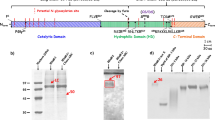Abstract
Intact and fully O[emsp4 ]-sulfonated glycosaminoglycans (GAGs) including chondroitin sulfate, dermatan sulfate, hyaluronan, heparan sulfate and heparin were chemically de-O-sulfonated on their hexosamine C-6 position (6-O[emsp4 ]-desulfonation) using N,O[emsp4 ]-bis(trimethylsilyl) acetamide. 1H NMR spectroscopy and chemical compositional analysis showed that the chemical de-O[emsp4 ]-sulfonation at C-6 position of hexosamine residues in both intact and fully O[emsp4 ]-sulfonated GAGs was completely achieved. Since GAGs and their derivatives are often used as anticoagulant agents, their anti-amidolytic activities were determined. While most of anticoagulant activity of fully O[emsp4 ]-sulfonated GAGs (FGAGs) and heparin disappeared following chemical 6-O[emsp4 ]-desulfonation, the activity of 6-O-desulfonated fully O[emsp4 ]-sulfonated dermatan sulfate (De6FDS) remained. This observation suggests the importance of the position of O-sulfonate groups for anti-coagulant activity.
Similar content being viewed by others
References
Kimata K, Okayama M, Oohira A, Suzuki S, Cytodifferentiation and proteoglycan biosynthesis. Mol Cell Biochem 1, 211–28 (1973).
Gallagher JT, Lyon M, Steward WP, Structure and function of heparan sulphate proteoglycans. Biochem J 236, 313–25 (1986).
Hascall VC, Midura RJ, Sorrell JM, Plaas AH, Immunology of chondroitin/dermatan sulfate. Adv Exp Med Biol 376, 205–16 (1995).
Hook M, Kjellen L, Johansson S, Cell-surface glycosaminoglycans. Annu Rev Biochem 53, 847–69 (1984).
Fraser JR, Laurent TC, Laurent UB, Hyaluronan: its nature, distribution, functions and turnover. J Intern Med 242, 27–33 (1997).
Casu B, Structural features and binding properties of chondroitin sulfates, dermatan sulfate, and heparan sulfate. Semin Thromb Hemost 17S, 9–14 (1991).
Linhardt RJ, Hileman RE, Dermatan sulfate as a potential therapeutic agent. Gen Pharmacol 26, 443–51 (1995).
Casu B, Structure and biological activity of heparin. Adv Carbohydr Chem Biochem 43, 51–134 (1985).
Linhardt RJ, Toida T, Heparin oligosaccharides-New analogs development and applications, in Witczak ZB, Nieforth KA (eds) Carbohydrates as drugs, New York, Marcel Dekker, pp 277–341 (1997).
Gunay NS, Linhardt RJ, Heparinoids: structure, biological activities and therapeutic applications. Planta Med 65, 301–6 (1999).
Lindahl U, Lindolt K, Spillmann D, Kjellen L, More to “heparin” than anticoagulation. Thromb Res 75, 1–32 (1994).
Linhardt RJ, Wang HM, Ampofo SA, New methodologies in heparin tructure analysis and the generation of LMW heparins. Adv Exp Med Biol 313, 37–47 (1992).
Razi N, Feyzi E, Bjork I, Naggi A, Casu B, Lindahl U, Structural and functional properties of heparin analogues obtained by chemical sulphation of Escherichia coli K5 capsular polysaccharide. Biochem J 309, 465–72 (1995).
Amiral J, Antigens involved in heparin-induced thrombocytopenia. Semin Hematol 36, 7–11 (1999).
Horne MK III, Hutchison KI, Simultaneous binding of heparin and platelet factor-4 to platelets: further insights into the mechanism of heparin-induced thrombocytopenia. Am J Hematol 58, 24–30 (1998).
Girolami A, Low molecular weight heparins in clinical practice: unsolved or partially solved problems. Arch Inst Cardiol Mex 68, 69–76 (1998).
Maruyama T, Toida T, Imanari T, Yu G, Linhardt RJ, Conformational changes and anticoagulant activity of chondroitin sulfate following its O-sulfonation. Carbohydr Res 306, 35–43 (1998).
Toida T, Maruyama T, Suzuki A, Imanari T, Linhardt RJ, Preparation and anticoagulant activity of fully O-sulphonated glycosaminoglycans. Int J Biol Macromol 26, 233–41 (1999).
Mikhailov D, Linhardt RJ, Mayo KM, NMR solution conformation of heparin-derived hexasaccharide. Biochem J 328, 51–61 (1997).
Qiu G, Toida T, Imanari T, Structural diversity of dermatan sulphate in procine dermis. Biol Pharm Bull 102, 721–6 (1997).
Pavao MS, Aiello KR, Werneck CC, Silva LC, Valenta AP, Mulloy B, Colwell NS, Tollefsen DM, Mourao PA, Highly sulfated dermatan sulfates from Ascidians. Structure versus anti-coagulant activity of these glycosaminoglycans. J Biol Chem 273, 27848–57 (1998).
Matsuo M, Takano R, Kamei-Hayashi K, Hara S, A novel regioselective desulfation of polysaccharide sulfates: Specific 6-O-desulfation with N,O-bis(trimethylsilyl)acetamide. Carbohydr Res 241, 209–15 (1993).
Linhardt RJ, in Varki A (ed.) Current Protocols in Molecular Biology, Vol. 2, Wiley Interscience, Boston, pp. 17.13.17–17.13.32 (1992).
Sanderson PN, Huckerby TN, Nieduszynski A, Conformational equilibria of alpha-L-iduronate residues in disaccharides derived from heparin. Biochem J 243, 175–81 (1987).
Sie P, Ofosu F, Fernandez F, Buchanan MR, Petitou M, Boneu B, Respective role of antithrombin III and heparin cofactor II in the in vitro anticoagulant effect of heparin and of various sulphated polysaccharides. Br J Haematol 64, 707–14 (1986).
Honda S, Suzuki S, Common conditions for high-performance liquid chromatographic microdetermination of aldoses, hexosamines, and sialic acids in glycoproteins. Anal Biochem 142, 167–74 (1984).
Colwell NS, Grupe MJ, Tollefsen DM, Amino acid residues of heparin cofactor II required for stimulation of thrombin inhibition by sulphated polyanions. Biochim Biophys Acta 1431, 148–56 (1999).
Edens RE, Al-Hakim A, Weiler JM, Rethwisch DG, Fareed J, Linhardt RJ, Gradient polyacrylamide gel electrophoresis for determination of molecular weights of heparin preparations and low-molecular-weight heparin derivatives. J Pharm Sci 81, 823–7 (1992).
Libersan D, Khalil A, Dagenais P, Quan E, Delorme F, Uzan A, Latour JG, The low molecular weight heparin, enoxaparin, limits infarct size at reperfusion in the dog. Cardiovasc Res 37, 656–66 (1998).
Toyoda H, Motoki H, Tanikawa M, Shinomiya K, Akiyama H, Imanari T, Determination of human urinary hyaluronic acid, chondroitin sulphate and dermatan sulphate as their unsaturated disaccharides by high-performance liquid chromatography. J Chromtogr 565, 141–8 (1991).
Toida T, Toyoda H, Imanari T, High resolution proton nuclear magnetic resonance studies on chondroitin sulfates. Anal Sci 9, 53–8 (1993).
Nadkarni VD, Toida T, Van Gorp CL, Schubert RL, Weiler JM, Hansen KP, Caldwell EEO, Linhardt RJ, Preparation and biological activity of N-sulfonated chondroitin and dermatan sulfate derivatives. Carbohydr Res 290, 87–96 (1996).
Author information
Authors and Affiliations
Rights and permissions
About this article
Cite this article
Toida, T., Suzuki, A., Nakajima, Ki. et al. Effect of 6-O-sulfonate hexosamine residue on anticoagulant activity of fully O-sulfonated glycosaminoglycans. Glycoconj J 17, 393–399 (2000). https://doi.org/10.1023/A:1007108131223
Issue Date:
DOI: https://doi.org/10.1023/A:1007108131223




